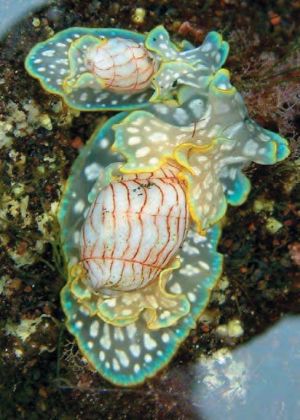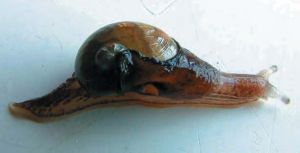|
A trip to La Palma, the most westerly of the volcanic Canary Islands, in February this year (incidentally during the coldest and wettest February weather experienced in the islands for more than forty years) provided the opportunity for a brief look at both the marine and nonmarine mollusc fauna. Examining the rock pools and black volcanic sand of the bay near our holiday apartment at Los Cancajos on the East coast I soon began to realise that the marine fauna here is a curious mixture of Atlantic, Mediterranean and West African influence. A spectacular find were animals of the Opisthobranch “bubble shell” Micromelo undatus (Brug., 1792) in a large rock pool on the lower shore (figure 1); this (Dance, 1983) or a similar species is also found on the other side of the Atlantic in the warm waters of Atlantic from Florida to Brazil. The remains of other species which indeed do travel the seas were also washed up on the shore: the spiral internal shells of the cephalopod Spirula spirula (L.1758); and two species of pelagic violet sea snails Janthina janthina (L. 1758) and the less common J. exigua (Lam. 1816). There were shells of species found in the UK such as Diodora graeca (L., 1758) and Turitella communis Risso, 1826 alongside familiar looking shells which are in fact Canary Island/Madeira/Azores endemics such as Gibbula candei (d’Orbigny, 1838), Littorina striata (King, 1832) and Patella candei d’Orbigny 1840. In addition were delicate shells of the Canary Island Ormer which has been described to be a form of a Caribbean species (H. coccinea Reeve, 1846) which settled on the Canaries [Haliotis coccinea canariensis F.Nordsieck 1975] however it is probably a southern form of the familiar H. tuberculata (L.,1758). Two other species I found here which are found on both sides of the Atlantic are Polonices lacteus (Guilding 1834) and the cowrie Erosaria spurca (L.,1758)( collectors sometimes call the cowries from the Canaries E. spurca form atlantica Monterosato, 1897). Walking on the shore one morning after stormy seas revealed what was for me the most exciting marine find, a perfect shell of the Terebrid Hastula lepida (Hinds, 1843); a West African species occasionally found on La Palma and Tenerife (and thus the only locality in Europe of a member of this family). Inland the island of La Palma is dominated in the north by the mountainous Caldera de Taburiente which is flanked by laurel forests of international importance. In the south around Fuencaliente is a landscape of more recent vulcanicity. There are small fields with stone walls together with some uncultavated areas. In such a varied landscape there are a number of possibilities to find a variety of nonmarine molluscs, and the wet weather helped on this occasion in what is often a dry landscape away from the cloud forest of the high calderas. As with the marine species, some of the landsnails were familiar from the UK such as Lauria cylindracea (Da Costa, 1778), Oxychilus draparnaudi (Beck, 1837) and Helis aspersa (Muller 1774). Perhaps the most common of the snails not found in the UK was the small helicigonid Caracolina lenticula (Michaud, 1831), under stones, beside walls, beneath plant litter on banks. Also common on walls and under stones in cultivated areas was Ferussacia follicula (Gmelin, 1790) (Figure 2) There was a specimen of the Canarian endemic genus Hemicycla, H. vermiplicata (Wollaston, 1878) on rocks under Pinus canariensis south of Monte de Luna where I also found representatives of the local Enidae genus Napaeus. In the laurel forest of the Los Tilos Biosphere Reserve was a large Vitrinid, probably the La Palma endemic Plutonia (Insulivitrina) solemi Ibanez & Alonso 2001 (Figure 3). Also in this area, whilst looking for fungi on a rotten log, a member of our party found a dead shell of another familiar UK species, Carychium (Saraphia) tridentatum (Risso, 1826). Although a dead shell it may represent the first record of this genus from La Palma. Other species found in a variety of localities include Monilearia and/or Xerotricha sp., but their identity remains to be confirmed. The Canary Islands have long been studied for their unique natural history. A naturalist friend of mine often says that if Darwin had visited the Canary instead of the Galapogos Islands he would have come to the same conclusions as he formulated his theory of evolution. The mollusc fauna is perhaps less spectacular than the botany, yet many workers have found it marked with the same uniqueness and interest. I would like to express my thanks to Adrian Norris for comments and help with identification of the non-marine specimens. |
Fig 1 (Photo Peter Topley)
Fig 2 (Photo Peter Topley)
Fig 3 (Photo Peter Topley) |
Strange and familiar: Some notes on Molluscs from La Palma, Canary Islands
Issue
9
Page
8



